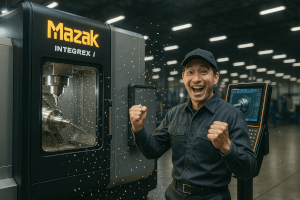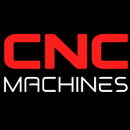AI & CNC Machines in 2025: What’s Hype, What’s Real, and What’s Next

AI & CNC Machines in 2025: What’s Hype, What’s Real, and What’s Next.
AI is already helping with toolpath optimization, chatter avoidance, thermal drift compensation, machine connectivity, and predictive maintenance. But it doesn’t replace fixturing skill, process engineering, part QA, safety compliance, or full “lights-out” autonomy. Expect rapid gains in simulation/digital twins, parameter recommendations inside CAM, and predictive maintenance—all dependent on clean shop-floor data, standards like MTConnect and OPC UA/umati, and adherence to machine-tool safety standards (ISO 16090-1). Explore: CNC machines for sale
What AI Is Doing Reliably Today (2025)
- CAM-side optimization & chatter avoidance
Modern CAM workflows and add-ons use AI/physics models to recommend stable feeds/speeds and avoid chatter—sometimes before the first cut—reducing cycle time and scrap. Siemens highlights digital twins around SINUMERIK ONE; Productive Machines (an AMRC spin-out) plugins for NX CAM aim to “get the best part first time” by predicting unstable conditions. Explore: CNC milling machines
- Thermal drift compensation & adaptive control at the CNC
Vendors like Mazak advertise AI-based thermal compensation (e.g., AI Thermal Shield) that automatically corrects for temperature changes to keep accuracy stable during longer runs. Treat vendor numbers as directional, but the automation trend is real. Explore: CNC turning centers
- Predictive maintenance (PdM) and condition monitoring
Machine-learning models for tool wear/failure prediction are now common in the literature and in commercial tools; when implemented with good sensors & labels, they reduce unplanned downtime and improve OEE. Explore: Sell your CNC machine
- Data collection & shop-floor connectivity
Standards matter. MTConnect gives a common, read-only vocabulary for machine data; OPC UA/umati provides read/write capabilities and standardized models for machine tools that MES/SCADA/ERP can use. HEIDENHAIN StateMonitor supports MTConnect/OPC UA, but OPC UA often requires certificate management and careful security. Explore: CNC Price Guide
What AI Still Can’t Do (and Why)
- End-to-end autonomy (“lights-out everything”) on job-shop variability
AI doesn’t yet generalize across changing materials, lots, fixtures, tool wear, and real-world surprises without curated data, robust sensing, and human oversight. The most credible wins remain narrow: chatter avoidance, parameter tuning, and PdM. Explore: Vertical machining centers
- Replace fixturing, setup, and process engineering judgment
GD&T interpretation, custom workholding, probe strategies, cutter selection, and sequencing still require expert humans. Current digital-twin standards (ISO 23247) help structure information, but they don’t eliminate real-world engineering work. Explore: 5-axis CNC machines
- Guarantee tolerance/surface finish without validation
Models can predict tendencies (e.g., surface quality, tool wear), but certification-grade repeatability still depends on in-process measurement, thermal control, spindles, tooling, and QA. Treat claims as “assistive,” not automatic. Explore: CNC inspection & metrology partners
- “Push-button” safety and compliance
Machine-tool safety remains governed by standards like ISO 16090-1:2022 for machining centers/milling/transfer machines. AI doesn’t waive risk assessment, guarding, or procedures.
Hype vs. Fact (Quick Table)
| Claim | Hype or Fact? | What Evidence Says | What to Do in 2025 |
|---|---|---|---|
| “AI will run our shop lights-out next quarter.” | Hype | Narrow wins are real; general autonomy is not. Data & variability limit generalization. | Target specific use-cases (chatter, PdM); instrument machines; iterate. |
| “Digital twins replace physical prove-outs.” | Partial | You can simulate programming and setup virtually (e.g., SINUMERIK ONE), but validation and probing still matter. | Use digital twin to cut prove-out time, keep in-process checks. |
| “AI picks perfect feeds/speeds on the first try.” | Partial | CAM plugins and dynamics modeling improve stability and cycle time but still need shop-specific calibration. | Start with pilot parts; capture results; build your parameter library. |
| “Plug-and-play machine data for any CNC.” | Partial | MTConnect is read-only; OPC UA/umati adds control, but integration/security/certs take work. | Plan connectivity project with IT/OT security & standards up front. |
| “AI will handle safety compliance.” | Hype | Safety is governed by ISO 16090-1 and similar; AI doesn’t replace risk assessment/guarding. | Keep human ownership of safety; document procedures & checks. |
Explore: Browse CNC categories
Data & Standards You Actually Need
- MTConnect (ANSI/MTC1.4-2018): Open, read-only data vocabulary for machines/sensors; reduces translation headaches and accelerates analytics dashboards.
- OPC UA / umati (OPC 40501 UA for Machine Tools): Read/write, standardized models for machine tools to connect to MES/ERP/analytics; umati drives harmonization.
- Digital twins (ISO 23247): A framework to structure manufacturing twins for products/processes/resources; helpful for shop simulation & traceability.
- Safety (ISO 16090-1:2022): Baseline safety requirements for machining centers, milling and transfer machines.
Explore: How much is my machine worth? (Price Guide)
What to Expect in the Next 12–24 Months
- Deeper digital-twin adoption for programming, setup, training, and process validation—especially with SINUMERIK ONE ecosystems.
- AI-assisted CAM everywhere: vendor and third-party plugins that recommend stable parameters and avoid chatter (e.g., Productive Machines + Siemens NX).
- Predictive maintenance that actually pays: better sensors + labeled datasets + standards-based connectivity → fewer nasty surprises and better OEE.
- Cleaner interoperability: growing maturity of OPC UA companion specs and umati profiles across machine tools.
- Risk management frameworks: manufacturers will increasingly map AI initiatives to NIST AI RMF 1.0 and ISO/IEC 23894:2023.
Explore: New vs. used CNC—what’s right for you?
Implementation Checklist (Realistic, not hype)
- Pick one high-ROI use-case (chatter on a recurring part, or PdM on a bottleneck spindle).
- Connect machines via MTConnect (fast read-only wins) or OPC UA/umati (if you need control loops). Expect certs and security work.
- Stand up a digital twin for programming/simulation where supported (e.g., SINUMERIK ONE).
- Wrap the project with NIST AI RMF / ISO 23894 so the CFO, QA, and EHS folks are aligned.
Explore: Request machine listings that match your parts
Mini Case Study: Digital Twin + Optimization on an Aerospace Job
Context: An aerospace supplier moves to a “digital-native” CNC control with vendor twin and CAM optimization.
- What they did
- Adopted SINUMERIK ONE with “Create/Run MyVirtual Machine” to simulate programming, setup, and operation on a PC before cutting chips.
- Layered AI-assisted machining optimization to avoid chatter and pick stable parameters.
- Connected machines to a dashboard using MTConnect/OPC UA for utilization & alarms.
- Outcomes reported (vendor case) Siemens cites customers achieving 20–30% productivity gains on 3- to 5-axis work after migrating to SINUMERIK ONE (case study: NWI Aerostructures). Treat as directional.
Before vs. After (illustrative KPI table)
| KPI | Before | After | How It Moved |
|---|---|---|---|
| Avg. cycle time (5-axis part) | 100% | ~80–85% | Digital twin + stable parameter selection reduced air-cut & chatter re-runs. |
| First-article prove-out hours | 100% | ~60–70% | Virtual setup/program validation caught collisions & gouges early. |
| Scrap/rework rate | Baseline | ↓ | Better stability & probing plans (still human-owned). |
| Unplanned downtime | Baseline | ↓ | PdM + dashboards surfaced anomalies earlier. |
Explore: CNC machines for aerospace work
Buyer’s Guide: Questions to Ask Vendors (Cut through the hype)
- Which standard do you support out-of-the-box: MTConnect (read-only) or OPC UA/umati (read/write)? Show me the data tags you expose.
- Can I run a pilot on my actual material/fixtures and compare to my current parameters? (Ask for part-specific proof, not general claims.)
- How do you secure OPC UA (certificates, roles), and what’s your plan for patching & IT policies?
- How does your tool align with NIST AI RMF / ISO 23894 (risk, validation, traceability)?
Explore: Request a machine match
The Bottom Line for 2025
- Treat AI as assistive power tools for programmers, machinists, and maintenance—not a replacement.
- Start with data you can trust, standards you can maintain, and one part family where payback is obvious.
- Bake in safety (ISO 16090-1) and AI risk management (NIST/ISO 23894) from day one.
Explore: Get your machine’s resale value
Sources & Further Reading (authority links)
- Digital twins & Siemens SINUMERIK ONE: Control Eng. (IMTS 2024)
- CAM optimization & chatter avoidance: Siemens + Productive Machines partnership (2025)
- Predictive maintenance & tool wear: ScienceDirect review (2023)
- Standards for connectivity: MTConnect overview (official)
- Digital-twin standards: ISO 23247 overview (ISO)
- Safety: ISO 16090-1:2022 (ISO) and public excerpts/samples
- Risk management for AI: NIST AI RMF 1.0 (2023; PDF)


